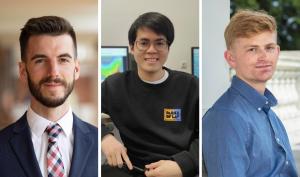
Three Ph.D. students studying at the University of Virginia with civil and environmental engineering professor Venkataraman “Venkat” Lakshmi, the John L Newcomb Professor of Engineering, are among the 2023 winners of the American Geophysical Union’s prestigious Michael H. Freilich Student Visualization Competition. The award is named for the former director of the NASA Earth Science Division.
The visualization competition calls for students to visualize data in creative ways and present complex problems in the scientific disciplines related to Earth and space with emphasis on communicating science to broad audiences. Grand prize winners will have the opportunity to present their research using NASA’S Hyperwall at AGU23, the union’s annual meeting in December.
Benjamin D. Goffin and Thanh Nhan Duc Tran were named grand prize winners, and Avery C. Walters earned runner-up honors. The students join Gigi Pavur, Robin Kim and Jessica Besnier as members of Lakshmi’s Hydrosense research group who have received the Michael Freilich award.
Lakshmi is a longtime AGU member and now president-elect of the union’s hydrology section. Much of his and his students’ work focuses on remote sensing of terrestrial processes related to hydrology (the study of the movement and distribution of water on and below ground) to provide decision-relevant information that is otherwise not available. Remote sensing uses means such as satellites and aircraft-mounted sensors to collect data about conditions on the ground from a distance.
In particular, Lakshmi’s group uses remote sensing and computer models to study hydrological extremes such as floods, droughts, landslides, wildfires and permafrost thaw.
Managing Irrigation During Drought With Help From Space
At the Union’s annual meeting, Goffin will present on water scarcity in Central Chile, drawing on dynamic visualizations he created to demonstrate how Earth observations from space can support sustainable agriculture and water sustainability.
For the past two summers, Goffin interned with the NASA Applied Sciences Capacity Building Program, a workforce development initiative, where he used data from NASA satellites to capture plant water demand and increased wildfire risk related to Chile’s megadrought.
More recently, working with Chilean stakeholders, Goffin examined data collected over time from a sensor aboard the International Space Station.
“Measurements from this vantage point allowed us to capture crop-water use at an unprecedented pixel resolution 50 times finer than before,” Goffin said.
“Part of the research we do is to transform these global datasets that span over many years into meaningful information and dynamic figures,” he said. “These visualizations are my best attempt at telling a story around the issue of water scarcity and showing firsthand how satellite observations can support irrigation management.”
For Water Resource Managers, Satellites Tell the Rainfall Story
Tran’s National Science Foundation-supported research concentrates on water resource management using remotely sensed datasets to improve the reliability of hydrological simulations.
In regions where ground and satellite data collection is limited, these computer models can help researchers and regional authorities evaluate the impacts of extreme weather events on people and the environment in support of sustainable development efforts. In general, the proliferation of satellite-based precipitation measurement products has improved models that predict rainfall in these data-scarce regions, Tran said.
His project proposes the Comprehensive Assessment Framework for Rainfall (CAFR), a novel way to evaluate six well-known products deployed across eleven river basins and over seven distinct climate regions. Of the six satellite-based products, Tran’s results suggest NASA’s Integrated Multi-satellitE Retrievals for Global Precipitation Measurement outperforms others and is a close second to following rain gauges.
“My visualizations validate these satellite precipitation dataset products, especially NASA’s, for imaging water processes across various river basins. This also confirms their usefulness for earth observation,” he said.
Visualizing the Toll of California’s Wildfires
As an undergraduate and Ph.D. student at UVA, Walters has contributed to a variety of projects, including mapping U.S. Forest Service buildings and producing digital renderings as an intern at NASA’s Goddard Space Flight Center.
Walters’ AGU project, which is part of his doctoral research, focuses on the impact of wildfires on the hydrology of California’s Feather River Watershed.
The 2018 Camp Fire, 2020 North Complex Fire and 2021 Dixie Fire burned more than 1.4 million of the watershed’s 2.3 million acres. Walters examined satellite data taken over time to analyze hydrological conditions before, during and after these wildfires, focusing on soil moisture, vegetation and evapotranspiration — the movement of water from land to atmosphere through evaporation and transpiration from plants. He also used visible and infrared satellite imagery to outline and analyze wildfire burn scars.
In addition to better understanding how hydrological conditions changed after the fires, Walters said, “This research aids in visualizing these complex relationships, which can inform future studies, mitigation efforts and management strategies in the region.”
Winners and runners-up of the Michael Freilich Student Visualization Competition earn stipends up to $6,000 to attend the AGU annual meeting and participate in professional development opportunities.